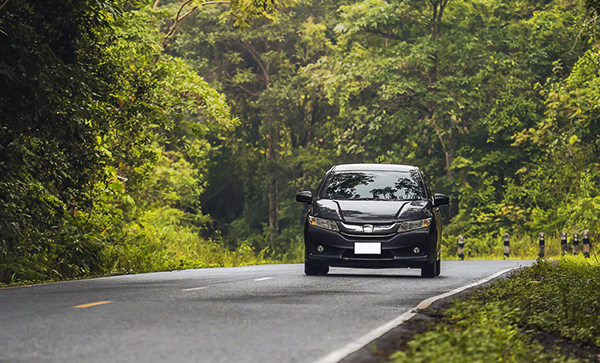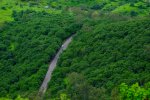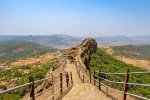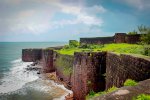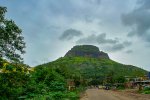- 55 Kms
4 / 5
- Reviews (0)
Location: Near Saswad
Perched atop a hill at a height of 4,472 feet above sea level, Purandar Fort is an historically significant ancient fort located near Saswad.
Info
Purandar Fort is an ancient fort situated about 55 km away from Pune and about 15 km away from Saswad. Perched atop a gigantic mountain mass, the fort stands at a height of about 4,472 feet above sea level. A smaller twin fort called Vajragad also lies atop the same hill. Purandar Fort is under the control of the Indian Army and one had to provide valid ID proofs to enter the premises. Civilians cannot venture into the parts of the fort which come under restricted areas. One has to deposit phones and cameras at the Army counters before entering the fort.
The earliest references to Purandar Fort date back to the Yadava Dynasty in the 11th century. After the Yadavas defeat, the fort was taken over by the kings of Bijapur and Ahmednagar. In 1596 AD, the fort was given as Jagir to Maloji Bhosale, grandfather of Shivaji. But several years later in 1646, Chhatrapati Shivaji Maharaj fought hard to conquer the fort again. His triumph by conquering Purandar Fort was one of his first victories. Chhatrapati Shivaji Maharaj’s son Chhatrapati Sambhaji Maharaj was born at Purandar Fort on 14th May 1657.
The fort was later besieged by Mughals after a mighty battle. During this war, Murar Baji Prabhu, a gallant Maratha commander was killed. A statue of the brave commander has been installed in the fort to commemorate him. However, Shivaji Maharaj recaptured it in 1670. Under the Peshwas, Purandar became a retreat for them whenever Pune was under attack. In 1776, the Marathas signed a treaty with the British, known as the second Treaty of Purandar. In 1818, Purandar Fort was invaded by a British force under General Pritzler.
The trek to reach the top of the fort is relatively easy. The route can become slippery during monsoon, so one needs to take precaution while traversing it. The base village is also known as Purandar. It takes about an hour or two to complete the trek, depending on one’s speed and fitness. The fort is in ruins, but it is an architectural marvel, nonetheless. One enters the fort through the Bini Darwaja, which is still intact. There are two distinct levels at the fort: the upper level is the Ballekilla and the lower level is the Machi. A staircase from the Machi leads to the Ballekilla, which where lies one of the greatest attractions inside the fort, the Dilli Darwaza. In addition, there are several other old buildings, water tanks and ancient remnants atop the fort.
Purandar Fort also houses of the Kedareshwar Temple and the temples dedicated to Lord Indra and Goddess Lakshmi. Several devotees of Lord Shiva visit the Kedareshwar Temple every year, especially on the auspicious occasion of Maha Shivratri. Surrounded by a lush green landscape, Purandar Fort offers some of the most beautiful and breathtaking views of the picturesque valley and area below. The entire locale comes alive during monsoon, which is the best time to visit Purandar Fort.
Facilities
- It is advisable to carry your own food and sufficient water for the trek.
- There is a small food stall near the parking area, which serves onion bhaji, vada-pavs, packaged chips, tea and water.
- Camping on top of the fort and littering the premises is strictly prohibited.
- Mode of Transport : The best way to reach car or bike. There is a motorable road that takes you halfway to the top the fort.
Things to do
- Explore the incredible Purandar Fort, the birthplace of Chhatrapati Shivaji Maharaj’s son, Chhatrapati Sambhaji Maharaj.
- Embark on a relatively easy fort to reach the top of the fort and enjoy the stunning scenery along the way.
- Once you reach the top of the fort, visit the Machi as well as the Balekilla. Marvel at the Dilli Darwaja, which is one of the highlights of this fort.
- Feel refreshed as you feast your eyes on the greenery all around the fort and enjoy the bird’s-eye views of the lush valleys below.
- Visit the wonderful Kedareshwar Temple, dedicated to Lord Shiva.
- Explore the other temples, old buildings, water tanks and ancient remnants situated atop the fort.
Photos + Add a photo
Map
Rent a Car
